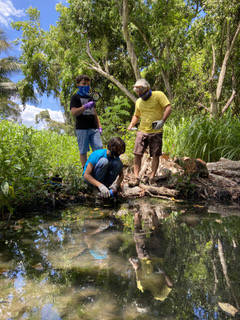Kilo Kai, to Observe the Ocean—Connecting Land Use and Its Impacts on the Nearshore Ecosystem

The NOAA Office of Education and NAAEE partnered to increase environmental and science literacy among NOAA’s partners and external networks. In this five-year partnership supported by the U.S. Department of Education, NOAA and NAAEE worked together to provide enriching after-school watershed-related STEM (science, technology, engineering, and mathematics) projects through NOAA-21st Century Community Learning Centers Watershed STEM Education Partnership grants. These grants supported programming for a total of 100 local 21st Century Community Learning Centers (21st CCLC) sites and their students. The 30 selected projects served 18 states, ranging from Alaska to Florida.
eeBLUE: Watershed Chronicles
This post is written by Derek Esibill, from the Pacific American Foundation in Hawaii.
The Kilo Kai project was built around the idea that biocultural restoration could improve ecosystem functionality and health as a land management practice. With this in mind, our students’ goals are to learn how to quantify ecosystem health in lowland, coastal, and nearshore environments using research quality instrumentation and industry standard practices. The information they collect during their meaningful watershed educational experiences (MWEEs) is intended to be passed along to researchers, resource stewards, the community, and used for their projects that deepen the connection to place.
COVID-19 has posed a particular challenge to a program designed to be hands-on and face-to-face. We have had to scale back face-to-face encounters for most of the project’s timeline. We have been observing county and state stay-at-home orders, pivoting to an online platform using Zoom, Google Classroom, and 360 virtual reality to deliver content and build relationships with each other and place. Through these “classroom” experiences, students learned the necessary skills of how to identify key coral species, conduct benthic surveys, identify fish, and quantify fish through virtual fish transect swims. Students also learned the basics of watershed biogeochemistry and how water changes as it flows from the land to the sea. In particular, we started close to our intended target number of participating students, however, participation has dwindled this semester; students indicate they are getting “zoomed” out and meeting times on Sundays from 10:00 AM–1:00 PM are a struggle. Our philosophy is that we need to support students, not stress them out, especially during this time of uncertainty. Likewise, participating teachers have been overwhelmed with added responsibilities and challenges of pivoting to a distance learning platform and have not engaged with us.
This reduction in numbers provided the opportunity to meet at outdoor locations while complying with local ordinances. As Kilo Kai is also an early college course, for those interested, we have received guidance from the University of Hawaiʻi regarding protocols on how to prevent the spread of COVID-19 and protect our students and their families. With these tools in place, we have met face to face three times, putting into practice what we have been studying. Students assisting graduate student Anita Tsang’s project, which explores octocorals as a bioindicator of eutrophication, conducted benthic coral surveys at predetermined locations in Kailua Bay. Water samples at these locations were also taken and are being analyzed for nutrient concentrations. Fish surveys were also taken to look for a correlation between reef health and fish abundance and diversity.

Students were also able to meet at the Waikalua Loko Iʻa, a 400-year-old, 16-acre Native Hawaiian fishpond (aquaculture facility). Fishponds like this were able to produce approximately 500 lbs of fish per acre annually, providing a much needed protein source to the community. As land use priorities changed with a changing demographic, fishponds were repurposed. Out of the estimated 488 throughout the state, only 70 remain, none of them functioning as food production hubs—Waikalua Loko Iʻa is one such pond. As part of the Kāneʻohe Bay estuarine system, Waikalua provided students the opportunity to explore a transitional ecosystem and contribute to the restoration of this ancient aquaculture facility. Students took water samples to investigate water quality in terms of oxygen, salinity, pH, nutrient concentrations, and pathogenic bacteria concentrations. This information is vital to the restoration of this fishpond. It is submitted to the Hawaiʻi Department of Health to help with the process of certifying the pond for food production. Feel free to take a virtual tour of the pond!
As we moved upstream towards inland and wetland environments, students met at Kōkua farm in Haleʻiwa, Oʻahu. The community run farm is currently overgrown with invasive plants and trees. It is situated just inland of Waialua Bay on, what appears to be, the hydrological boundary between the freshwater lens and saltwater intrusion. Consequently, there are freshwater seeps that are slightly saline along the northern side of the property. This water flows gently into Waialua Bay. Students have discovered that the water is eutrophic, and there are vast differences between wet and dry seasons.
It has been such an honor and a privilege to work with these students and the communities, thank you so much for this opportunity.



